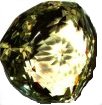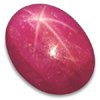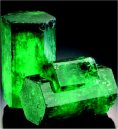 Diamond
Diamond
This is the hardest of minerals, classified 10 on the Mohs Scale. The crystal structure of the diamond is a cube (see crystal forms for more information). Although diamonds are made completely of carbon, carbon dating cannot be used to estimate the age of diamond deposits because they are too old. Instead, scientists use other radioactive materials, in particular uranium and lead which can be found as impurities in diamonds. Using the decay of these impurities it has been shown that all naturally-formed diamonds are at least 990 million years old. Some are more than 3.2 billion years old.
Most diamonds which we see are transparent, but coloured diamonds also exist. Coloured diamonds may be yellow, green, brown, or shades of pink. Larger pink diamonds are quite rare and very expensive. So, how rare are diamonds altogether? Typically, a diamond deposit yields about 5grams of gems for every 1000kg of mined material. In addition, only 20% of the diamonds found are gem quality. The remaining 80% are used in industry. So it is safe to say that gem quality diamonds are very rare!
Diamond deposits can be divided into two major groups: volcanic pipes, also known as kimberlite pipes and alluvial deposits, which were formed by the erosion of diamond pipes over millions of years. Although small deposits of diamonds can be found in many places, the major diamond mines are in South Africa, Yacutia in Russia, Zaire, Brazil and India.
 Beryl
Beryl
This is a silicate mineral containing the element beryllium. Beryl crystals can be very large because the silicate tetrahedra are linked to form rings. The most famous variety of beryl is emerald. Emeralds are brittle and most have impurities (known as inclusions), so large flawless stones are very rare and expensive. To conceal some of their microfissures and to improve their appearance, emeralds are usually treated with polymers or colourless oil. The most valuable emeralds are a transparent variety of beryllium aluminosilicate containing small amounts of chromic oxide which give the stone its bright green colour. In the ancient world emeralds were the highest valued of all gems. They were linked with the goddess Aphrodite as a symbol of immortality and faith.
The finest emeralds come from Columbia. Other emerald-rich mines can be found in Zambia, Brazil, Madagascar, Russia, India and Pakistan.

 Corundum
Corundum
Corundum is an aluminium oxide with a hexagonal crystal structure. The red variety of corundum is better known as ruby. Sapphire exists almost in any colour, although the most common varieties are blue . Corundum comes mainly from metamorphic and volcanic rocks. Both rubies and sapphires are often heat-treated by jewellers to enhance their colour and hide impurities. The distinctive “pigeons blood” coloured rubies from Mogok (Burma) are the most expensive rubies on earth. Nowadays because of heat-treatment the price of rubies has gone down. Rubies and sapphires are found mainly in Burma, Thailand, Sri Lanka, although "pinkish rubies" come most commonly from Vietnam, Madagascar and southern Tanzania.
Rubies and sapphires were known and treasured by the Egyptians. There are even biblical references to rubies, referring to them as the most precious of stones, although it is likely that the stones called rubies in the Old Testament and other ancient texts may actually have been garnets or spinels. (Even in the British Crown Jewels there is a 'ruby' which is actually a spinel!)
